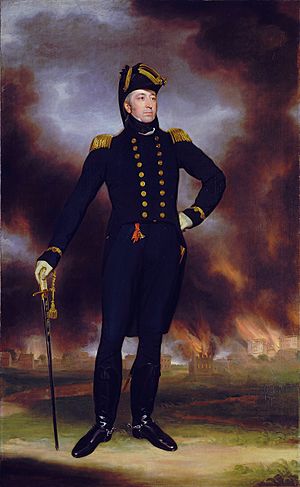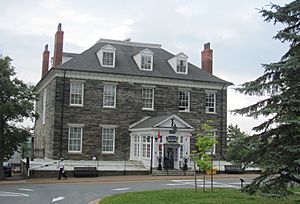Sir George Cockburn, 10th Baronet facts for kids
Quick facts for kids
Sir
George Cockburn
|
|
|---|---|

Portrait of Sir George Cockburn by John Lucas
|
|
| Born | 22 April 1772 London, England |
| Died | 19 August 1853 (aged 81) Leamington Spa, England |
| Buried |
Kensal Green Cemetery, London
|
| Allegiance | |
| Service/ |
|
| Years of service | 1786–1846 |
| Rank | Admiral of the Fleet |
| Commands held | HMS Speedy HMS Inconstant HMS Minerve HMS Meleager HMS Phaeton HMS Captain HMS Pompée HMS Implacable Cape of Good Hope Station North American Station |
| Battles/wars | French Revolutionary Wars Napoleonic Wars War of 1812 |
| Awards | Knight Grand Cross of the Order of the Bath |
Sir George Cockburn (born April 22, 1772, died August 19, 1853) was a very important officer in the Royal Navy of Britain. He rose to the highest rank, Admiral of the Fleet. During his long career, he fought in several major wars, including the French Revolutionary Wars, the Napoleonic Wars, and the War of 1812. He is especially known for his role in the Burning of Washington during the War of 1812. Later in his life, he helped improve the Navy by focusing on better gunnery training and new ship technology like steam power. He also worked to make sure sailors were treated fairly.
Contents

George Cockburn was born in London, England. He joined the Royal Navy when he was just nine years old, in March 1781. He started as a captain's servant, which was a common way for young boys to begin their naval careers back then. Over the years, he moved up the ranks, serving on many different ships.
By 1793, he became a lieutenant, and then a commander of a ship called HMS Speedy. In 1794, he was promoted to the rank of captain. He commanded HMS Meleager and later the frigate HMS Minerve.
Key Battles and Commands
Captain Cockburn took part in important battles during the French Revolutionary Wars. In 1797, he was at the Battle of Cape St Vincent, where the British Navy won a big victory against the Spanish fleet. His bravery during this battle was noted.
Later, during the Napoleonic Wars, he led naval support for the capture of Martinique in 1809. This was a successful operation, and he received thanks from the British Parliament for his efforts. In 1809, he also commanded a group of warships during the Walcheren Campaign, helping with landings in the Netherlands.
He even tried to help the King of Spain escape from prison in 1810, but the mission did not succeed. By 1811, he was promoted to commodore, a senior naval rank.
The War of 1812 and Washington

In 1812, Cockburn became a rear admiral. He was sent to the North American Station to fight in the War of 1812 against the United States. He was the second-in-command to the main admiral in the region.
Cockburn was very active along the American coast, especially in the Chesapeake Bay. He would capture American ships, disrupt trade, and raid ports. His actions were meant to cause problems for the Americans and make them less supportive of the war.
One of the most famous events he was involved in was the capture and Burning of Washington on August 24, 1814. He advised Major General Robert Ross on the attack. Cockburn believed that Washington, D.C., could be captured easily.
British troops, with Cockburn's help, marched to Washington. They successfully took the city. Cockburn suggested burning the whole city, but General Ross decided to only burn public buildings. This included the White House and the United States Capitol. Private homes were mostly spared.
After the battle, Cockburn oversaw the destruction of a newspaper office. He famously said that all the "C's" (referring to the printing type for the letter C) should be destroyed so the newspaper could not "abuse" his name anymore. For his service, he was made a Knight Commander in the Order of the Bath in 1815.
After the Wars
In 1815, Cockburn had the important job of taking Napoleon I to Saint Helena, a remote island where Napoleon would live in exile. Cockburn stayed on the island for several months as its governor and commander of the naval forces there.
He continued to receive honors, becoming a Knight Grand Cross of the Order of the Bath in 1818. He was promoted to vice-admiral in 1819 and became a member of the Fellow of the Royal Society in 1820, which is a group of top scientists.
Cockburn's Political Life
Sir George Cockburn also had a career in politics. He was elected as a Member of Parliament for Portsmouth in 1818. He served as a Junior Naval Lord, helping to manage the Navy.
He continued to be elected to Parliament for different areas. In 1828, he became the First Naval Lord, which is a very high position in the Navy's leadership. In this role, he worked to improve how sailors were trained, especially in gunnery. He helped create a special gunnery school in Portsmouth.
He also focused on making sure the Navy used the latest technology, like steam-powered ships. He believed in treating sailors well and reducing the need for harsh physical punishment.
Cockburn served as First Naval Lord several times. He was promoted to full admiral in 1837. In 1851, he reached the highest naval rank: Admiral of the Fleet. He inherited his family's baronetcy in 1852.
Sir George Cockburn passed away on August 19, 1853, at Leamington Spa. He is buried in Kensal Green Cemetery in London.
Places Named After Cockburn
Several places around the world are named after Sir George Cockburn:
- Cockburn Sound in Western Australia was named by Captain James Stirling in 1827.
- Cockburn Island, near the tip of the Antarctic Peninsula, was named by Sir James Clark Ross during his expedition between 1839 and 1843.
- Cape Cockburn and Cockburn Bay on Nelson Island, Canada, also bear his name.
Family Life
In 1809, George Cockburn married his cousin, Mary Cockburn. They had one daughter who survived, Augusta Harriot Mary Cockburn. She later married Captain John Cochrane Hoseason.
Interestingly, Sir George Cockburn is a distant cousin of the writer Alexander Cockburn and the actress Olivia Wilde.


